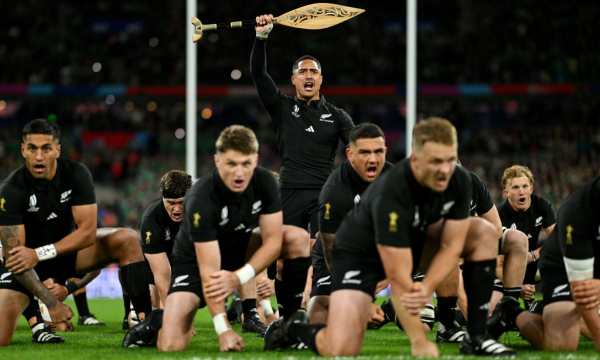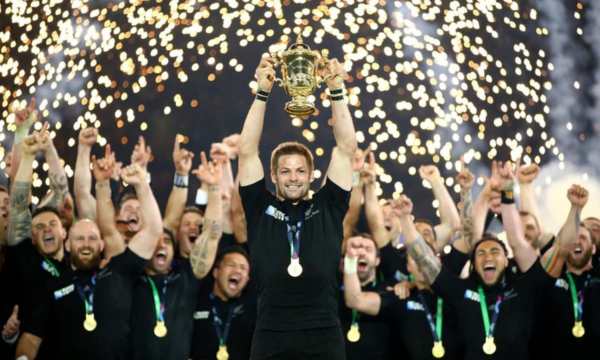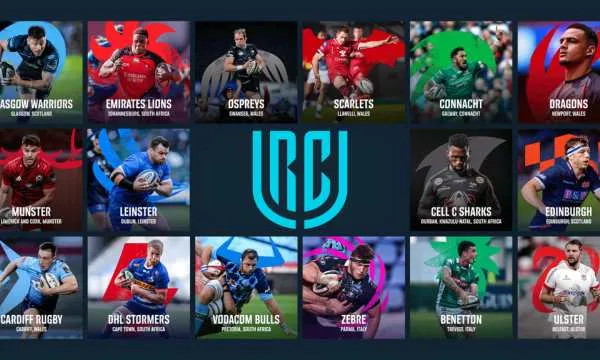All Blacks: The Most Dominant Rugby Team
Get to know the most dominant rugby union team from New Zealand: the All Blacks.
Ad
When the men in black take the field, the rugby world stops to watch a display of skill, strength, and tradition that few can match.
The aura of invincibility surrounding the All Blacks has been built over more than a century of dominance in the sport, with a win rate that no other national team has achieved.
Discover why this New Zealand team has become the standard of excellence in world rugby and how its influence extends far beyond the field.
The Emergence of the New Zealand National Team
The history of the All Blacks officially began in 1903, when they adopted the name that would become legendary in the world of sports.
The term originated during a tour of England in 1905 when a British journalist referred to the team as “All Blacks” due to their all-black uniforms.
Before this, New Zealand had already played international matches, but it was under this new identity that the country began its trajectory of dominance.
The early years set the standard of excellence that would characterize the team for generations. The 1905-1906 tour of the Northern Hemisphere resulted in 34 wins out of 35 games, sending a clear signal to the rugby world.
The only setback came against Wales, in a controversial match that New Zealanders still contest to this day.
The silver fern on the chest became the iconic symbol of the All Blacks, representing New Zealand’s national pride.
This deep identification between the team and the country explains why rugby has become so beloved in New Zealand.
Children grow up dreaming of wearing the black jersey with the silver fern and representing their nation in the country’s most cherished sport.
Why Are the All Blacks So Feared?
The All Blacks have built their intimidating reputation through a unique combination of technical excellence and physical intensity rarely seen in other teams.
When New Zealand players execute their moves with mechanical precision, it seems like they are playing a different sport from everyone else.
The execution of basic skills under extreme pressure is what sets this team apart from other national teams.
The intimidating aura of the players begins well before the opening whistle, with the performance of the traditional Maori haka.
This ancestral war dance, performed with visceral intensity, establishes a psychological advantage even before the first physical contact.
Many teams admit to feeling mentally shaken when facing the tribal challenge of the New Zealanders head-on.
New Zealand’s player development system is possibly the most efficient in the rugby world.
From primary schools to professional clubs, young athletes are taught the fundamentals of the “All Blacks game” – based on skill, speed, and decision-making.
This system produces complete players who reach the international level already prepared to maintain the standard of excellence.

The-All-Blacks-Haka-(Source-Google)
A Win Rate That Haunts the Sporting World
The New Zealand team maintains a win rate of over 77% throughout its century-long history, an unparalleled record among elite sports teams.
This consistency spans different generations, playing systems, and changes in rugby rules. Between 2009 and 2019, this rate reached an impressive 89%, demonstrating that the men in black have taken their dominance in modern rugby to new heights.
At home, on the sacred soil of New Zealand, the players in black are practically unbeatable.
Stadiums like Eden Park in Auckland have become almost impenetrable fortresses, where the team remained undefeated for over 40 consecutive games between 1994 and 2023.
This home advantage demonstrates the immense pressure visitors face when playing in New Zealand.
The ability to consistently win under pressure is reflected in their three World Cup titles (1987, 2011, and 2015). They are the only team to have successfully defended a Rugby World Cup title.
Impressive statistics:
- 18 Rugby Championship/Tri Nations titles (more than all other competitors combined).
- Record of 18 consecutive international victories (2015-2016).
- The first and only team to win the Rugby World Cup in consecutive years (2011 and 2015).
- Held the world number 1 ranking for over 80% of the time since its creation.
The period between 2011 and 2015 is considered by many experts as the golden era of New Zealand rugby.
The Black Giants Who Made Their Mark on the Field
Throughout their century-long history, the All Blacks have produced some of the greatest players rugby has ever seen.
Richie McCaw, with his 148 international games and two World Cup titles as captain, personifies the team’s warrior spirit. His ability to operate on the edge of the rules and physical dominance redefined the flanker position in modern rugby.
Dan Carter is widely regarded as the best fly-half in rugby history, combining extraordinary kicking skills with impeccable tactical vision.
His performance in the 2015 World Cup final against Australia represents the perfection the team strives for in every match.
Jonah Lomu revolutionized the sport in the 90s with his unique combination of size, power, and speed. All Blacks legends:
- Richie McCaw: Record-holder with 148 international games and the only two-time World Cup-winning captain.
- Dan Carter: Top international points scorer (1,598 points) and considered the best fly-half in history.
- Jonah Lomu: Revolutionized rugby with his impressive physique and unusual speed for his size.
- Colin Meads: Icon of the 60s-70s, known as “Pinetree” for his physical endurance.
- Sean Fitzpatrick: One of the greatest hookers in history and a global rugby ambassador.
New Zealand’s player culture consistently produces players who redefine their positions. From Sir Wilson Whineray in the 60s to Beauden Barrett in the current era, the tradition of excellence remains unshaken.
The respect for the black jersey with the silver fern creates a responsibility that each player carries with pride and humility.

McCaw-captained-the-2015-World-Cup-(Source-Google)
Understanding the All Blacks Haka Versions
The haka has become an indispensable part of the All Blacks’ identity, representing a deep connection to New Zealand’s Maori traditions. The pre-game ritual is not just a spectacle – it is a demonstration of respect for the country’s cultural roots.
In 2005, the New Zealand team introduced a new haka called “Kapa o Pango,” created specifically for the team.
This more intense version includes direct references to rugby and New Zealand’s identity in the sport. The final gesture, symbolizing drawing the sun to the chest, represents vital energy being drawn into the body before battle.
How opponents respond to the haka often becomes a spectacle in itself. From the silent respect of the English to the frontal challenge of France in the 2011 World Cup, each response generates its own narrative.
Some of rugby’s most intense rivalries have been heightened by these emotionally charged pre-game confrontations.
The All Blacks Winning Mentality and Culture
The All Blacks’ philosophy transcends the playing field and is based on the Maori concept of “whakapapa” – the connection between past, present, and future.
Each player understands that they are only “borrowing the black jersey,” with the responsibility of leaving it in a better state than they found it. This mentality creates a continuous legacy of excellence that spans generations.
The famous motto “sweep the sheds” perfectly exemplifies their culture. Even the team’s biggest stars clean the locker room after training and games, demonstrating that no one is above the group.
This deliberate humility combats the development of inflated egos that could harm team cohesion.
The leadership system divides responsibilities among several experienced players, not just the captain. This “leadership group” makes joint decisions and maintains conduct standards on and off the field.
The pressure of representing a rugby-obsessed nation is transformed into positive motivation through this collective support.
Epic Matches Against Historic Rivals
The rivalry between the All Blacks and Springboks is considered the most intense and historic in world rugby, loaded with sporting and social significance.
Since their first encounter in 1921, the two Southern Hemisphere powerhouses have played matches that defined eras in the sport. The 1995 World Cup, won by South Africa at home, represented the emotional peak of this rivalry.
The clashes between the All Blacks and Wallabies for the Bledisloe Cup have created unforgettable moments in rugby. Since 2003, New Zealand’s dominance in this bilateral competition has been almost total, with rare Australian victories.
The intensity of these South Pacific derbies always produces rugby of the highest technical and physical quality.
The British & Irish Lions tours to New Zealand represent special events on the rugby calendar.
Only on three occasions (1971, 1993, and 2017) have the Lions managed to avoid series defeats against the New Zealanders, demonstrating the extreme difficulty of winning on New Zealand soil.
The balanced 2017 series (1-1-1) is considered one of the greatest confrontations of the modern era.
The Future of the All Blacks in Modern Rugby
The migration of New Zealand talent to foreign clubs with lucrative contracts represents a constant threat to the national team’s depth.
The New Zealand Rugby Union works tirelessly to find the balance between retaining talent and financial sustainability.
The tactical evolution of modern rugby forces the All Blacks to constantly reinvent their playing style. The system that favored skill and speed had to adapt to the growing emphasis on defense and physical contests.
Coaches like Ian Foster and his predecessor Steve Hansen have the challenging task of maintaining traditional identity while incorporating necessary tactical innovations.
The increasing global competitiveness is seen as an opportunity, not a threat. The New Zealand national team historically strengthens when challenged, using occasional setbacks as fuel for evolution.
New generations of players like Will Jordan and Ardie Savea carry the weight of tradition while adding their own contributions to the legacy of the men in black.
Conclusion
The legacy of the All Blacks goes far beyond the trophies won or records set.
The influence of the New Zealand team can be seen in the way rugby is played worldwide, with an emphasis on skill and creativity even in a sport of intense physical contact.
The haka before matches has become one of the most recognizable rituals in world sports, symbolizing respect for cultural traditions.
As rugby continues to evolve in the professional era, the All Blacks remain a reference for excellence and adaptability.
FAQ
What is the significance of the silver fern?
Why do the All Blacks conduct end-of-year tours in Europe?
What happens when an All Blacks player retires?
What is the importance of the Bledisloe Cup to the All Blacks?
What was Jonah Lomu’s impact on world rugby?
 Want to Watch Rugby Live on Your iPhone? Discover the Best Apps
Want to Watch Rugby Live on Your iPhone? Discover the Best Apps
Watch all the games directly on your iPhone, follow every play in real-time and never miss a thrilling moment, wherever you are. Ad Tired of missing […]
Keep reading Rivalries and Unmissable Matches in the United Rugby Championship
Rivalries and Unmissable Matches in the United Rugby Championship
Dive into the heart pounding world of the United Rugby Championship where legendary rivalries create unforgettable sporting moments. Ad This championship has become the ultimate battleground […]
Keep reading Watch NRL Live: Best Apps for Android
Watch NRL Live: Best Apps for Android
With NRL live apps, rugby fans can catch favorite matches anytime, even when busy or away from home. Ad With the right Android apps, you can […]
Keep reading